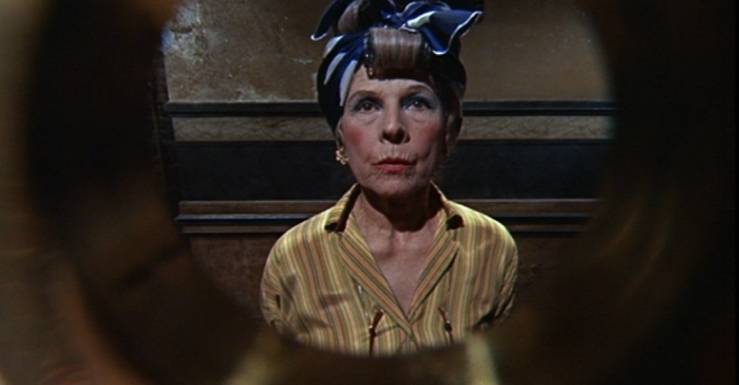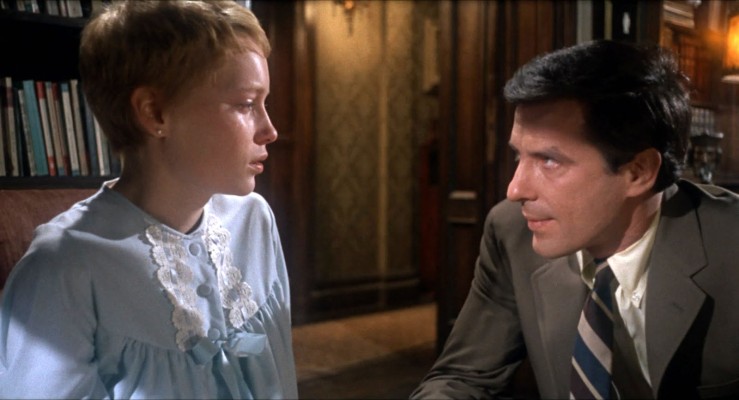
There is little I can say about Roman Polanski’s seminal 1968 horror marvel, Rosemary’s Baby, which hasn’t already been written, so I’ll simply preface this review by saying that I believe this film is the pinnacle of the horror genre and possesses everything that many modern day horror films sadly lack. I tend to stray away from the heavily overused ‘masterpiece’ label for several reasons, the main one being that I wonder if any of us truly have the authority to brand a film as such when it carries such concrete, objective connotations. I am struggling, however, to think of a more suitable term to describe this film and its exceptional structure and pacing, which, of course, are fundamental aspects of what makes any horror film truly unnerving.
The slow-burning tension is perhaps the film’s most noteworthy feature. It follows the strange and suspicious events which surround the titular Rosemary (Mia Farrow) and her husband Guy (John Cassavetes) upon moving into their new apartment with the hope of starting a family. After befriending their somewhat peculiar neighbours, Minnie and Roman Castavet, Rosemary becomes increasingly anxious about the wellbeing of her unborn child, regularly being presented with odd gifts and so-called health supplements to support her pregnancy. Played by an Oscar-winning Ruth Gordon, Minnie is one of the film’s most enigmatic characters, never breaking away from her overbearingly sickly sweetness, yet exhibiting enough dark peculiarity to place us in the same state of uncertainty as Rosemary herself. Polanski provides subtle and masterfully-placed hints as to the fate of Rosemary and her baby, yet there is never a point at which the audience becomes complacent in their knowledge of the characters and their motives. This level of unpredictability is where the film excels.

The costumes and set design within Rosemary’s Baby are utterly fantastic. Minnie and Roman are quite the ostentatious, eccentric couple; their lurid fashion sense extending the facade of warmth and hospitality they sustain throughout their friendship with Rosemary. Polanski’s direction takes this even further, with the many exchanges between Minnie and Rosemary taking place from behind partially-closed doors, illustrating her growing distrust for those around her as her pregnancy progresses. Rosemary’s smart and fashionable wardrobe makes her physical transformation throughout the course of the film all the more harrowing in terms of mirroring her mental deterioration. The film’s crescendo results in the reduction of Rosemary into a child: her rapidly growing fears over the intentions of her neighbours, doctor and acquaintances are no longer taken seriously by anyone. This is where things become truly terrifying, playing on a fear which is likely shared by every single viewer. The idea of being consumed by paranoia, and ignored or silenced by those around us, to the point of potential insanity is enough to really get under the skin of anyone watching. Mia Farrow’s performance is exceptional, with her slow and chilling mental fragmentation providing much of the film’s pathos.

Of course, I could not discuss Rosemary’s Baby without mentioning how beautiful and mesmerising every single frame looks. It exemplifies the fine art of creating a genuinely disturbing horror film, yet also making it visually breathtaking through its vibrant colour use, as well as building an emotionally compelling narrative. There is a great deal to be learnt from a film as skilfully constructed as this, with the slow progression of Rosemary’s paranoia and the unsettling behaviour of those within her apartment block creating real, tangible fear, allowing us to fully invest in our protagonist’s terror without any reliance on jump scares, gimmicks or gore.
The apartment block location is well-utilised with regards to enhancing the audience’s curiosity about its inhabitants and their unsavoury intentions, and makes the film’s bizarre ending all the more unexpected. It has been debated whether the ‘horror’ label is warranted, considering most of its fear is built up through atmosphere rather than explicit visuals, but I am very much of the opinion that Rosemary’s Baby is indeed a horror film, and remains genuinely horrifying from beginning to end. Like Rosemary, I was never quite certain of who to trust, and what the suspiciously satanic activities of the apartment block’s residents would eventually culminate in. It held my complete, undivided attention for the entire runtime and was a completely unforgettable cinematic experience that I can’t wait to return to.


I liked this film and likewise would hesitate to call it a masterpiece, but for different reasons. Had I seen it in 1968, I think masterpiece would’ve come to mind, but today it feels like a transition to modern filmmaking for both Polanski and Hollywood as a whole. Too many of its plot points landed wrong, especially when compared to Polanski’s Chinatown 6 years later. If only he could’ve put off Rosemary’s Baby a few years.
LikeLike
Yeah I think I agree with you that it would be totally different viewing it for the first time in 1968. It’s a brilliant film though despite its flaws, and still serves as a masterclass for modern horror directors I think. Thanks for reading! 🙂
LikeLike